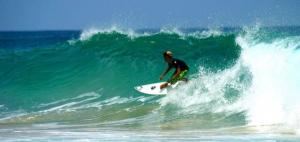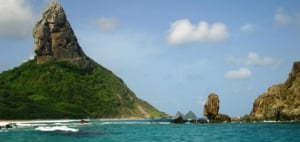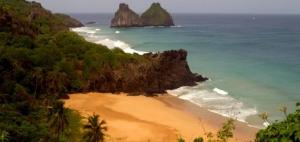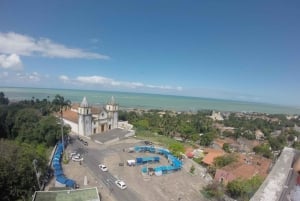Fernando de Noronha
The Fernando de Noronha archipelago is an island paradise that regularly appear on those 'top 10 in the world' destinations listings with stunning photos of marine wildlife and deserted beaches.
The islands already appeared on Portuguese maps in 1500, the same year as the Brazilian mainland was claimed, and the archipelago was officially claimed for Portugal in 1503 by Américo Vespúcio in the exploratory expedition led by Gonçalo Coelho, and financed by the brazil-wood timber trader Fernão de Loronha. For two centuries the islands were fought over by European colonial powers due to their strategic position in the equatorial South Atlantic.
In 1737 the State of Pernambuco reoccupied the islands as a prison and exile for minorities (gipsies, indians, political prisoners).
In 1893 the transatlantic subsea telecommmunications cables arrived with the British, then French and Italian companies and the first airstrip was built in 1934. During the 2nd World War, the islands hosted a US airbase and Federal Brazilian prison.
Control was returned to Pernambuco in 1988 when the Marine preservation park was founded and eco-tourism is nowadays the main economic activity.
In 2001 the archipelago was named a UNESCO world natural heritage site and has been protected as a Brazilian Federal marine park since 1988 covering 85% of its area, due to its outstanding marine habitats, teeming with dolphins, turtles, whales and sharks, over 250 species of fish and marine birdlife, and well preserved coral reefs. Even Charles Darwin dropped by in 1832.
In total the archipelago has 21 islands, with only Fernando de Noronha itself inhabited (~3000 residents) and the numbers of visitors are strictly controlled and pay a daily environmental fee of R$43.20 (~US$22) which rises in line with inflation every January.
Visitors are guaranteed a select group of fellow travellers, including many celebrities that pass through this bit of paradise. Normally visitors stay for between 3-7 days in the Pousadas or guesthouses on the island, which can range from very simple rooms to let to modern luxury accomodation fit for superstars.
In September 2012, an additional fixed fee was introduced to enter the marine preservation national park, PARNANORONHA, of R$130 (foreigners) or R$65 (Brazilians) valid for up to 10 days.
Superb Watersports
It boasts extremely good conditions for scuba diving and snorkelling and there are several professional operations on the islands providing training, equipment hire and excursions. For those less adventurous, there are boat tours including a glass-bottomed boat.
It is also a prime site for surfing, and it hosts an annual Hang Loose competition normally in February, when the waves rolling in from the Atlantic are best. There are plenty of options to learn for novices with instructors and board hire.















